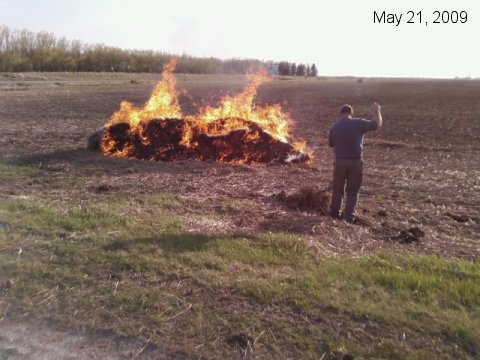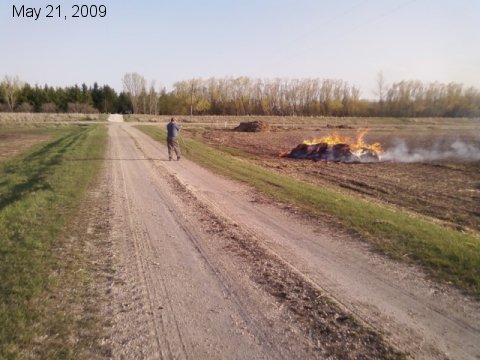

Gord burns a small pile of flood debris but can't get to the bigger ones until he can get into the field to till a fire break. Still too wet.

Still lots of flood debris to get rid of.
More of the water is gone from the flat each day.
Gord Checks out the what's left of the flood waters.
Many people have been asking about how our culvert worked so well when so many who use some of the more traditional and readily available solutions didn't work so well this flood year. One of the most widely used solutions uses water pressure to keep a hinged metal plate closed when there is flooding. Many of those had leakage problems this year as they froze open or were held open with flood debris. Once the outer dike culvert end goes under water, it's a very dangerous and tricky operations to attempt to fix a problem like that. But as in any flood, even Gord's design has it's hazzards. Wait too long to put the plate on and your bolting on the plate in the freezing cold flood waters from above. Leave too much water inside the dike and you will have a gusher when you do start to unbolt the plate to take it off.
This next series of pictures shows Gord's more unique solution for dike culvert closure mechanisms.
This 24 inch culvert has a flange on the outside end that a steel plate can be bolted too. Here you can still see the steel plate and it's rubber inner tube gasket. Soon Gord will take this plate off completely to stow it away for the summer/winter to get the rubber out of the sunlight. When this plate is bolted in place, Gord will leave some water on the inside of the dike to put pressure on the inside of this plate and try to equalize the pressure from the outside to the inside once it floods outside. From the culvert entrance inside the dike to the culvert plate outside, the level drops about 2 feet.
Here is a close up of the back of the plate and the bolts and nuts that normally will hold this plate tight onto the culvert flange.
Another view of the bolt/flange setup.
The flange is attached to the culvert with a culvert join section sealed and bolted in place to hold it.
Another view of the flange seals.
Today's look off the back of the dike. The field road is once again emerging at the far tree line and the flat is beginning to be defined again. Won't be long now before all the fields below are above water again.
Go back to the main 2009 Farm Flood page.
Last updated January 5,2017